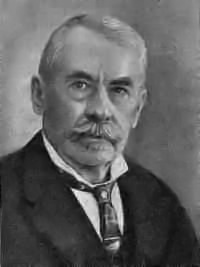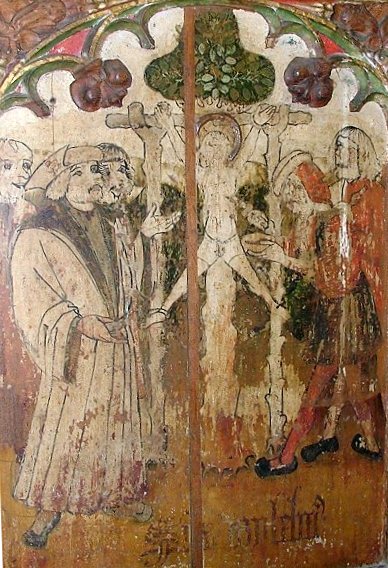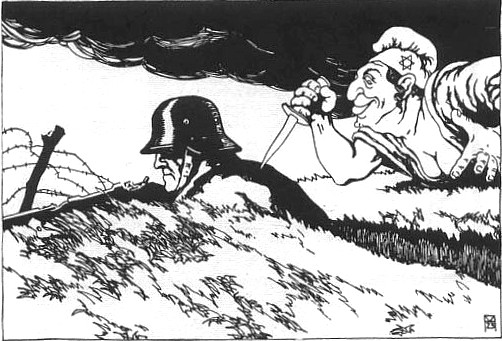|
Reichshammerbund
Reichshammerbund (Reich Hammer League) was a German anti-Semitic movement founded in 1912 by Theodor Fritsch. Based on ''The Hammer'', a journal founded by Fritsch in 1902, the Bund argued that Jewish influences had contaminated Germany and attempted to argue that their racism had a basis in biology. The aim of the group was to co-ordinate the activities of the many small anti-Semitic organisations active at the time and to bring as many of these as possible under its banner. A movement rather than a political party, it sought to be above party politics and to instead encourage a renewal of the German way of life from an anti-capitalist perspective. The battle sign of the group was the swastika, making the Bund one of the first Völkisch movements to use the symbol. The founding document for ''The Hammer'' had been Willibald Hentschel's 1901 book ''Varuna'', which preached racial purity and antisemitism. A sister organisation, the ''Germanenorden'', also appeared in 1912 under Frits ... [...More Info...] [...Related Items...] OR: [Wikipedia] [Google] [Baidu] |
Theodor Fritsch
Theodor Fritsch (born Emil Theodor Fritsche; 28 October 1852 – 8 September 1933), was a German publisher and journalist. His antisemitic writings did much to influence popular German opinion against Jews in the late 19th and early 20th centuries. His writings also appeared under the pen names Thomas Frey, Fritz Thor, and Ferdinand Roderich-Stoltheim. He is not to be confused with his son, also Theodor Fritsch (1895–1946), likewise a bookseller and member of the SA. Life Fritsch was born Emil Theodor Fritsche, the sixth of seven children to Johann Friedrich Fritsche, a farmer in the village of Wiesenena (present-day Wiedemar) in the Prussian province of Saxony, and his wife August Wilhelmine, née Ohme. Four of his siblings died in childhood. He attended vocational school ('' Realschule'') in Delitzsch where he learned casting and machine building. He then undertook study at the Royal Trade Academy (''Königliche Gewerbeakademie'') in Berlin, graduating as a technic ... [...More Info...] [...Related Items...] OR: [Wikipedia] [Google] [Baidu] |
Guido Von List Society
Guido Karl Anton List, better known as Guido von List (5 October 1848 – 17 May 1919), was an Austrian occultist, journalist, playwright, and novelist. He expounded a modern Pagan new religious movement known as Wotanism, which he claimed was the revival of the religion of the ancient German race, and which included an inner set of Ariosophical teachings that he termed Armanism. Born to a wealthy middle-class family in Vienna, List claimed that he abandoned his family's Roman Catholic faith in childhood, instead devoting himself to the pre-Christian god Wotan. Spending much time in the Austrian countryside, he engaged in rowing, hiking, and sketching the landscape. From 1877 he began a career as a journalist, primarily authoring articles on the Austrian countryside for nationalist newspapers and magazines. In these he placed a '' völkisch'' emphasis on the folk culture and customs of rural people, believing that many of them were survivals of pre-Christian, pagan religion. ... [...More Info...] [...Related Items...] OR: [Wikipedia] [Google] [Baidu] |
Germanic Mysticism
Armanism and Ariosophy are esoteric ideological systems that were developed largely by Guido von List and Jörg Lanz von Liebenfels respectively, in Austria between 1890 and 1930. The term 'Ariosophy', which means the wisdom of the Aryans, was invented by Lanz von Liebenfels in 1915, and during the 1920s it became the name of his doctrine. For research of the topic, such as Nicholas Goodrick-Clarke's book ''The Occult Roots of Nazism'', the term 'Ariosophy' is used generically to describe the Aryan/esoteric theories of a subset of the ' Völkische Bewegung'. This broader use of the word is retrospective and it was not generally current among the esotericists themselves. List actually called his doctrine 'Armanism', while Lanz used the terms 'Theozoology' and 'Ario-Christianity' before the First World War. The ideas of Von List and Lanz von Liebenfels were part of a general occult revival that occurred in Austria and Germany during the late 19th and early 20th centuries; a reviva ... [...More Info...] [...Related Items...] OR: [Wikipedia] [Google] [Baidu] |
Philipp Stauff
Philipp Stauff (1876–1923) was a prominent German/Austrian journalist and publisher in Berlin. He was an enthusiastic Armanist, a close friend of Guido von List, and a founding member of the Guido-von-List-Society. He was also the obituarist for List in the '' Münchener Beobachter''. Stauff joined the List Society in 1910 and swiftly graduated to the High Armanen Order, the intimate inner circle around List. In 1912 he became a committee member of the List Society and a generous patron. He was the chief German representative of the High Armanen Order at Berlin. His esoteric treatise ''Runenhäuser'' (''Rune Houses''), published in 1912, "extended the Listian thesis of 'armanist' relics with the claim that the ancient runic wisdom had been enshrined in the geometric configuration of beams in half-timbered houses throughout Germany". (See also Runic significance of timber framing.) He was active in both the Reichshammerbund and the Germanenorden (pre-World War I ... [...More Info...] [...Related Items...] OR: [Wikipedia] [Google] [Baidu] |
Alfred Roth
Alfred Roth (born 27 April 1879 in Stuttgart – died 9 October 1948 in Hamburg) was a German politician and writer noted for his anti-Semitism. He was sometimes known by his pseudonym Otto Arnim. Away from politics, he was a leading figure in the Commercial Employees Union. Early years The son of a photographer, Roth trained as an accountant and worked in that capacity for an ironmonger.Philip Rees, ''Biographical Dictionary of the Extreme Right Since 1890'', Simon & Schuster, 1990, p. 333 In 1897 he took up a role in the office of the ''Deutschnationaler Handlungsgehilfen-Verband'' (DHV), a white-collar union, and from 1908 to 1911 he edited their journal ''Deutsche Handelwache''. Briefly a member of the rightist ''Deutsche Jungbund'' in 1896, Roth was strongly influenced by the anti-Semitism that dominated the DHV and became politically active. He met Georg Ritter von Schönerer in 1904 and became an enthusiastic supporter of his pan-German ideas and was an unsuccessful parlia ... [...More Info...] [...Related Items...] OR: [Wikipedia] [Google] [Baidu] |
Germanenorden
The Germanenorden (Germanic or Teutonic Order) was an occultist and '' völkisch'' secret society in early 20th-century Germany. Its aim was to monitor Jews and spread antisemitic material. History The Germanenorden was founded in Berlin in 1912 by Theodor Fritsch and several prominent German occultists including Philipp Stauff, who held office in the Guido von List Society and High Armanen Order as well as Hermann Pohl, who became the Germanenorden's first leader. The order was a clandestine movement that wished to create a small but devoted group and was a sister movement to the more open and mainstream Reichshammerbund. Richard S. Levy, ''Antisemitism: A Historical Encyclopedia of Prejudice and Persecution, Volume 1'', ABC-CLIO, 2005, p. 269 In 1916, during World War I, the Germanenorden split into two parts. Eberhard von Brockhusen became the Grand Master of the "loyalist" Germanenorden. Pohl, previously the order's Chancellor, founded a schismatic offshoot: the Germanenord ... [...More Info...] [...Related Items...] OR: [Wikipedia] [Google] [Baidu] |
Political Organisations Based In Germany
Politics (from , ) is the set of activities that are associated with making decisions in groups, or other forms of power relations among individuals, such as the distribution of resources or status. The branch of social science that studies politics and government is referred to as political science. It may be used positively in the context of a "political solution" which is compromising and nonviolent, or descriptively as "the art or science of government", but also often carries a negative connotation.. The concept has been defined in various ways, and different approaches have fundamentally differing views on whether it should be used extensively or limitedly, empirically or normatively, and on whether conflict or co-operation is more essential to it. A variety of methods are deployed in politics, which include promoting one's own political views among people, negotiation with other political subjects, making laws, and exercising internal and external force, including w ... [...More Info...] [...Related Items...] OR: [Wikipedia] [Google] [Baidu] |
Antisemitism In Germany
Antisemitism (also spelled anti-Semitism)—prejudice, hatred of, or discrimination against Jews— has experienced a long history of expression since the days of ancient civilizations, with most of it having originated in the Christianity, Christian and pre-Christian civilizations of Europe. While it has been cited as having been expressed in the intellectual and political centers of ancient Greece and the Roman Empire, the phenomenon received greater institutionalization within European Christianity following the dissolution of the ancient center of Jewish culture, Jerusalem, resulting in the Jewish ghettos in Europe, forced segregation of Jewish populations and restrictions on their participation in the public life of European society at times. In the 20th century, antisemitism , particularly during the reign of Nazi Germany, resulted in the Holocaust, a program of systematic murder and dislocation of the majority of Europe's Jewish population. Roman Empire Middle Ages A ... [...More Info...] [...Related Items...] OR: [Wikipedia] [Google] [Baidu] |
Stab-in-the-back Legend
The stab-in-the-back myth (, , ) was an antisemitic conspiracy theory that was widely believed and promulgated in Germany after 1918. It maintained that the Imperial German Army did not lose World War I on the battlefield, but was instead betrayed by certain citizens on the home front—especially Jews, revolutionary socialists who fomented strikes and labor unrest, and other republican politicians who had overthrown the House of Hohenzollern in the German Revolution of 1918–1919. Advocates of the myth denounced the German government leaders who had signed the Armistice of 11 November 1918 as the "November criminals" (german: Novemberverbrecher, label=none). When Adolf Hitler and the Nazi Party rose to power in 1933, they made the conspiracy theory an integral part of their official history of the 1920s, portraying the Weimar Republic as the work of the "November criminals" who had "stabbed the nation in the back" in order to seize power. Nazi propaganda depicted Wei ... [...More Info...] [...Related Items...] OR: [Wikipedia] [Google] [Baidu] |
Anecdotal Evidence
Anecdotal evidence is evidence based only on personal observation, collected in a casual or non-systematic manner. The term is sometimes used in a legal context to describe certain kinds of testimony which are uncorroborated by objective, independent evidence such as notarized documentation, photographs, audio-visual recordings, etc. When used in advertising or promotion of a product, service, or idea, anecdotal reports are often called a testimonial, which are highly regulated in some jurisdictions. When compared to other types of evidence, anecdotal evidence is generally regarded as limited in value due to a number of potential weaknesses, but may be considered within the scope of scientific method as some anecdotal evidence can be both empirical and verifiable, e.g. in the use of case studies in medicine. Other anecdotal evidence, however, does not qualify as scientific evidence, because its nature prevents it from being investigated by the scientific method. Where only one o ... [...More Info...] [...Related Items...] OR: [Wikipedia] [Google] [Baidu] |
First World War
World War I (28 July 1914 11 November 1918), often abbreviated as WWI, was one of the deadliest global conflicts in history. Belligerents included much of Europe, the Russian Empire, the United States, and the Ottoman Empire, with fighting occurring throughout Europe, the Middle East, Africa, the Pacific, and parts of Asia. An estimated 9 million soldiers were killed in combat, plus another 23 million wounded, while 5 million civilians died as a result of military action, hunger, and disease. Millions more died in genocides within the Ottoman Empire and in the 1918 influenza pandemic, which was exacerbated by the movement of combatants during the war. Prior to 1914, the European great powers were divided between the Triple Entente (comprising France, Russia, and Britain) and the Triple Alliance (containing Germany, Austria-Hungary, and Italy). Tensions in the Balkans came to a head on 28 June 1914, following the assassination of Arch ... [...More Info...] [...Related Items...] OR: [Wikipedia] [Google] [Baidu] |




